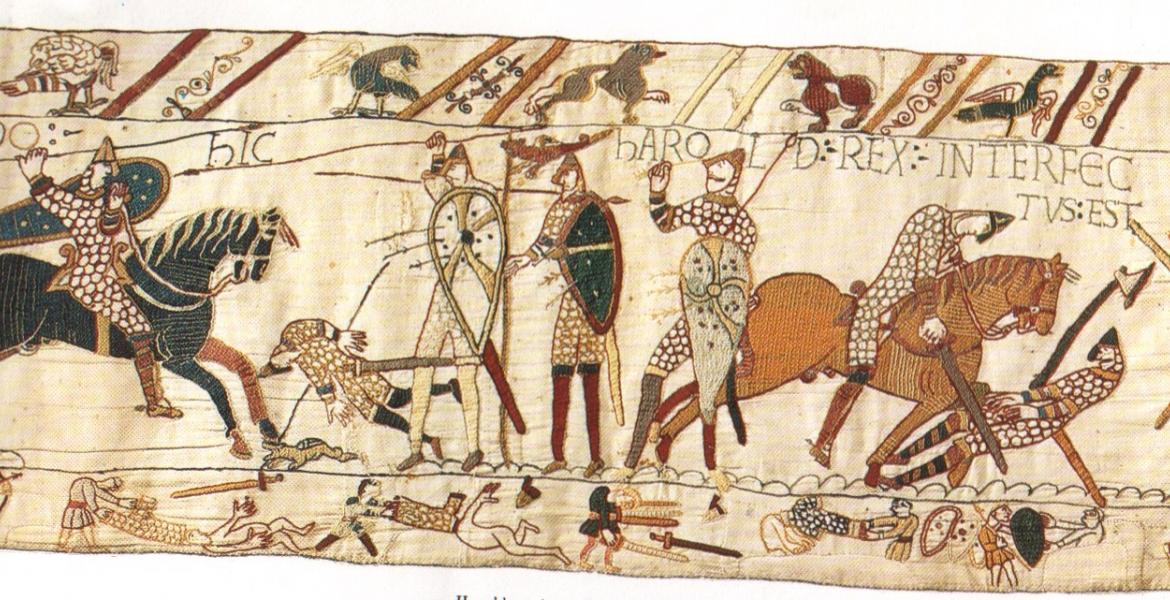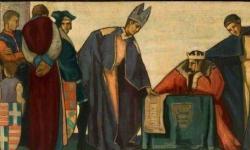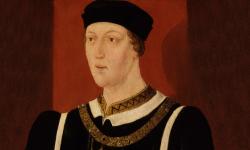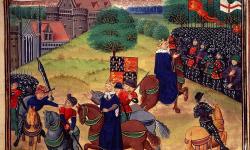The Battle of Hastings
Key facts about the Battle of Hastings
- The Battle of Hastings took place on 14 October 1066
- It was fought between the Normans and the English
- William of Normandy ('the Conqueror') defeated Harold Godwinsson
- As a result of the battle, William became king of England
People you need to know
- Edgar Ætheling - son of Edward the Exile and great-nephew of Edward the Confessor.
- Edward the Confessor - king of England between 1042 and 1066 who died childless. Read our article on him here.
- Harold Godwinsson - powerful politician who was named ruler of England in 1066.
- Harald Hardrada - king of Norway from 1046 until 1066.
- William of Normandy - illegitimateIn terms of children, those born out of wedlock (to unmarried parents).In terms of children, those born out of wedlock (to unmarried parents).In terms of children, those born out of wedlock (to unmarried parents). son of Robert I, duke of Normandy; and duke of Normandy from 1035.
The Battle of Hastings is considered to be one of the most important battles of England's history. Often taken as the definitive point when England stopped being Anglo-Saxon and instead became Norman - with all the associated changes in government and culture - it was in fact long-lasting, hard-fought and visceral. And it was by no means a foregone conclusion.
Background to the battle
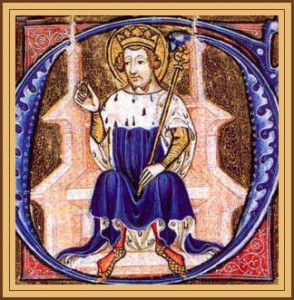
Edward the Confessor died childless on 5 January 1066, and Harold Godwinsson, an exceptionally wealthy and powerful noble who had no royal blood, declared he had been named as heir on Edward's deathbed. The WitangemotAn Anglo-Saxon council of elders, literally translated as 'council of the wise'., the leading men in the country, agreed and Harold was hastily consecrated as king just one day after. This was exceptionally fast for an Anglo-Saxon king, and must have raised a few eyebrows at the time, as it has done since. By being consecrated, Harold was showing that he was God's anointed, which would quiet any murmurings or dissentAn opinion or belief that goes against official teaching or commonly held views.An opinion or belief that goes against official teaching or commonly held views.An opinion or belief that goes against official teaching or commonly held views. and prevent people from questioning the convenience of Edward dying without a named heir and behind closed doors. In so doing, Harold angered William of Normandy, who had a distant claim to the throne,
This was exceptionally fast for an Anglo-Saxon king, and must have raised a few eyebrows at the time, as it has done since. By being consecrated, Harold was showing that he was God's anointed, which would quiet any murmurings or dissentAn opinion or belief that goes against official teaching or commonly held views.An opinion or belief that goes against official teaching or commonly held views.An opinion or belief that goes against official teaching or commonly held views. and prevent people from questioning the convenience of Edward dying without a named heir and behind closed doors. In so doing, Harold angered William of Normandy, who had a distant claim to the throne, His aunt, Emma of Normandy, had been the wife of two previous kings of England: Æthelred II ('the Unready') and Cnut. and who had perhaps already been named as Edward's heir.
His aunt, Emma of Normandy, had been the wife of two previous kings of England: Æthelred II ('the Unready') and Cnut. and who had perhaps already been named as Edward's heir. Whether or not he had will be debated by historians for a long time yet. Some, such as Marc Morris, think it likely as they shared a common cultural background and were kinsmen. It has been suggested that the throne was offered to William just to spite his father-in-law and possible enemy, Earl Godwin. Others argue against this, as Edward the Confessor knew it was the Witenagemot who decided succession and he had been attempting to help his own exiled nephew return to England.
Whether or not he had will be debated by historians for a long time yet. Some, such as Marc Morris, think it likely as they shared a common cultural background and were kinsmen. It has been suggested that the throne was offered to William just to spite his father-in-law and possible enemy, Earl Godwin. Others argue against this, as Edward the Confessor knew it was the Witenagemot who decided succession and he had been attempting to help his own exiled nephew return to England.
Furthermore, Godwinsson and William had a history: when Harold narrowly avoided shipwreck off the coast of Normandy in 1064 and was taken hostageA person seized or held as security for the fulfilment of a conditionA person seized or held as security for the fulfilment of a conditionA person seized or held as security for the fulfilment of a condition by the count of Ponthieu, William came to his aid. It is not known what Harold was doing in the English Channel in 1064. Norman sources have it that he was on his way to pay homage to Edward's heir. Many historians think that it might have been to help family members who had been taken hostage, or that it was simply a fishing trip. It is clear that he boarded a boat at Bosham, but beyond that we don't know. It is likely that a storm caused it to founder near Ponthieu. They spent some time fighting together against the duke of Brittany, after which William knighted Harold. But more importantly, Harold swore an oath on holy relicsParts of a deceased holy person's body or belongings kept as an object of reverence, or something from an earlier time.Parts of a deceased holy person's body or belongings kept as an object of reverence, or something from an earlier time.Parts of a deceased holy person's body or belongings kept as an object of reverence, or something from an earlier time. that he would support William's claim to the throne and 'that he would strive to the utmost with his counsel and with his wealth to ensure that the English monarchyThe king/queen and royal family of a country, or a form of government with a king/queen at the head.The king/queen and royal family of a country, or a form of government with a king/queen at the head.The king/queen and royal family of a country, or a form of government with a king/queen at the head. should be pledged to [William] after Edward's death'.
It is not known what Harold was doing in the English Channel in 1064. Norman sources have it that he was on his way to pay homage to Edward's heir. Many historians think that it might have been to help family members who had been taken hostage, or that it was simply a fishing trip. It is clear that he boarded a boat at Bosham, but beyond that we don't know. It is likely that a storm caused it to founder near Ponthieu. They spent some time fighting together against the duke of Brittany, after which William knighted Harold. But more importantly, Harold swore an oath on holy relicsParts of a deceased holy person's body or belongings kept as an object of reverence, or something from an earlier time.Parts of a deceased holy person's body or belongings kept as an object of reverence, or something from an earlier time.Parts of a deceased holy person's body or belongings kept as an object of reverence, or something from an earlier time. that he would support William's claim to the throne and 'that he would strive to the utmost with his counsel and with his wealth to ensure that the English monarchyThe king/queen and royal family of a country, or a form of government with a king/queen at the head.The king/queen and royal family of a country, or a form of government with a king/queen at the head.The king/queen and royal family of a country, or a form of government with a king/queen at the head. should be pledged to [William] after Edward's death'. William of Poitiers, The Gesta Guillelmi, quoted in Marc Morris, The Norman Conquest, London: Windmill (2012) p.142 Both Norman and later English sources agree this happened, but the English ones state it was done under duress, as the only way Harold could return home safely. The Norman ones, however, say the oath was willingly given. According to the Normans, therefore, William had a sacred duty to invade England and rid it of an oath-breaker.
William of Poitiers, The Gesta Guillelmi, quoted in Marc Morris, The Norman Conquest, London: Windmill (2012) p.142 Both Norman and later English sources agree this happened, but the English ones state it was done under duress, as the only way Harold could return home safely. The Norman ones, however, say the oath was willingly given. According to the Normans, therefore, William had a sacred duty to invade England and rid it of an oath-breaker. As a result of this alleged oath-breaking and also because England was seen as a haven for sinners, Pope Alexander II even blessed William’s banner before the invasion, turning the invasion into a war approved by the Christian God. This meant that those who perpetrated atrocities during the invasion would not be punished as severely as those in other wars.
As a result of this alleged oath-breaking and also because England was seen as a haven for sinners, Pope Alexander II even blessed William’s banner before the invasion, turning the invasion into a war approved by the Christian God. This meant that those who perpetrated atrocities during the invasion would not be punished as severely as those in other wars.
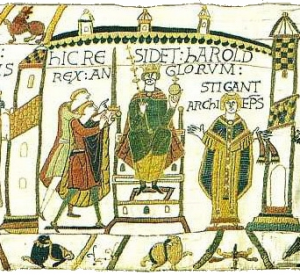
Harold was expecting trouble in 1066, He had sent spies over to Normandy and the immense ship-building programme underway there must have been a big clue. The Ship List - the first written account we have of formal Norman feudalOf, or relating to, a Medieval social structure where, in theory, the nobility would protect everyone, the peasants would pay for this protection by working the land, and the clergy would pray for everyone. In the secular world, the monarch was at the top of the pyramid, with each layer of nobility and commons owing services or favour to the layers above and below them. Although the term relates to the Middle Ages, it was not actually coined until the 16th century, so some medievalists don't like it.Of, or relating to, a Medieval social structure where, in theory, the nobilityThe highest hereditary stratum of the aristocracy, sitting immediately below the monarch in terms of blood and title; or the quality of being noble (virtuous, honourable, etc.) in character. would protect everyone, the peasants would pay for this protection by working the land, and the clergyThe people ordained for religious duties, especially in the Christian Church. would pray for everyone. In the secularNot connected with religious matters. world, the monarchA king, queen, or emperor was at the top of the pyramid, with each layer of nobility…Of, or relating to, a Medieval social structure where, in theory, the nobilityThe highest hereditary stratum of the aristocracyA generic term for the highest social class., sitting immediately below the monarch in terms of blood and title; or the quality of being noble (virtuous, honourable, etc.) in character. would protect everyone, the peasants would pay for this protection by working the land, and the clergyThe people ordained for religious duties, especially in the Christian Church. would pray for everyone. In the secularNot connected with religious matters. world, the monarchA king, queen, or emperor was at the top of the pyramid, with each layer of nobility… obligations - lists 14 names and the number of ships they were required to provide for the invasion fleet, with some being obliged to provide over 100 each. Even without this, a terrible omen appeared in the sky in April 1066, forewarning of imminent disaster: Halley's Comet. and kept his army on the south coast of England for much of the summer, awaiting an invasion force that couldn't sail due to unfavourable winds. This would have been a logistical nightmare for both armies. Marc Morris suggests that around 25 tons of grain and 30,000 gallons of water would be needed every day to keep the Norman army of 7,000 men and 2,000 horse alive on basic rations. To keep moraleThe confidence, enthusiasm, and discipline of a person or group at a particular time.The confidence, enthusiasm, and discipline of a person or group at a particular time.The confidence, enthusiasm, and discipline of a person or group at a particular time. high, meat, fish, wine and ale would also have been required. In addition, the waste all these people and animals produced needed to have been dealt with to avoid disease.
He had sent spies over to Normandy and the immense ship-building programme underway there must have been a big clue. The Ship List - the first written account we have of formal Norman feudalOf, or relating to, a Medieval social structure where, in theory, the nobility would protect everyone, the peasants would pay for this protection by working the land, and the clergy would pray for everyone. In the secular world, the monarch was at the top of the pyramid, with each layer of nobility and commons owing services or favour to the layers above and below them. Although the term relates to the Middle Ages, it was not actually coined until the 16th century, so some medievalists don't like it.Of, or relating to, a Medieval social structure where, in theory, the nobilityThe highest hereditary stratum of the aristocracy, sitting immediately below the monarch in terms of blood and title; or the quality of being noble (virtuous, honourable, etc.) in character. would protect everyone, the peasants would pay for this protection by working the land, and the clergyThe people ordained for religious duties, especially in the Christian Church. would pray for everyone. In the secularNot connected with religious matters. world, the monarchA king, queen, or emperor was at the top of the pyramid, with each layer of nobility…Of, or relating to, a Medieval social structure where, in theory, the nobilityThe highest hereditary stratum of the aristocracyA generic term for the highest social class., sitting immediately below the monarch in terms of blood and title; or the quality of being noble (virtuous, honourable, etc.) in character. would protect everyone, the peasants would pay for this protection by working the land, and the clergyThe people ordained for religious duties, especially in the Christian Church. would pray for everyone. In the secularNot connected with religious matters. world, the monarchA king, queen, or emperor was at the top of the pyramid, with each layer of nobility… obligations - lists 14 names and the number of ships they were required to provide for the invasion fleet, with some being obliged to provide over 100 each. Even without this, a terrible omen appeared in the sky in April 1066, forewarning of imminent disaster: Halley's Comet. and kept his army on the south coast of England for much of the summer, awaiting an invasion force that couldn't sail due to unfavourable winds. This would have been a logistical nightmare for both armies. Marc Morris suggests that around 25 tons of grain and 30,000 gallons of water would be needed every day to keep the Norman army of 7,000 men and 2,000 horse alive on basic rations. To keep moraleThe confidence, enthusiasm, and discipline of a person or group at a particular time.The confidence, enthusiasm, and discipline of a person or group at a particular time.The confidence, enthusiasm, and discipline of a person or group at a particular time. high, meat, fish, wine and ale would also have been required. In addition, the waste all these people and animals produced needed to have been dealt with to avoid disease. Morris, The Norman Conquest p.153. He got his figures from an earlier paper by Bernard Bachrach in Anglo-Norman Studies called 'Some Observations on the Military Administration of the Norman Conquest', 8 (1989). The Norman army coped well with the delay: they stayed at the coast waiting patiently and, according to William of Poitiers, behaving remarkably well.
Morris, The Norman Conquest p.153. He got his figures from an earlier paper by Bernard Bachrach in Anglo-Norman Studies called 'Some Observations on the Military Administration of the Norman Conquest', 8 (1989). The Norman army coped well with the delay: they stayed at the coast waiting patiently and, according to William of Poitiers, behaving remarkably well. An army such as this would tend to 'live off the land', which basically means plundering the goods, food, and anything else belonging to the peasantry living around them. That the Norman army didn't says a lot for their discipline and organisation. But on 8 September 1066, Harold dismissed his army, no longer able to feed them, hoping the approaching autumn would delay William until the next year.
An army such as this would tend to 'live off the land', which basically means plundering the goods, food, and anything else belonging to the peasantry living around them. That the Norman army didn't says a lot for their discipline and organisation. But on 8 September 1066, Harold dismissed his army, no longer able to feed them, hoping the approaching autumn would delay William until the next year.
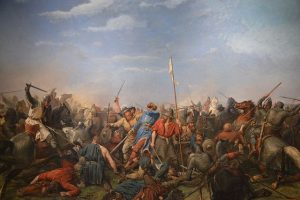
Unknown to Harold, there was an imminent threat from another quarter. Harald Hardrada, king of Norway (and with an exceedingly tenuous claim to the English throne), had decided to invade the north of England to claim the crown for himself. Harthacnut, who had briefly been king of England between 1040 and 1042, had made a pact with Hardrada's father, Magnus I of Norway, that whoever died first would pass on their lands to the other. By this reckoning, when Harthacnut died, England should have passed to Magnus I. Magnus, however, never had opportunity - or inclination - to pursue the claim. The sudden appearance of an invading army in the north of the country forced Harold to march his just-disbanded army to York, where he defeated Hardrada at the Battle of Stamford Bridge on 25 September.
Harthacnut, who had briefly been king of England between 1040 and 1042, had made a pact with Hardrada's father, Magnus I of Norway, that whoever died first would pass on their lands to the other. By this reckoning, when Harthacnut died, England should have passed to Magnus I. Magnus, however, never had opportunity - or inclination - to pursue the claim. The sudden appearance of an invading army in the north of the country forced Harold to march his just-disbanded army to York, where he defeated Hardrada at the Battle of Stamford Bridge on 25 September. It is said that the Norwegians fought honourably: the English are said to have been held back at the bridge for a considerable time by a single Norwegian. Others stories recount how Hardrada died having gone beserk, with no armour and using both hands on his sword. His army was so badly defeated that of the 200-300 boats needed to bring the force to England, only 24 were required for the return journey.
It is said that the Norwegians fought honourably: the English are said to have been held back at the bridge for a considerable time by a single Norwegian. Others stories recount how Hardrada died having gone beserk, with no armour and using both hands on his sword. His army was so badly defeated that of the 200-300 boats needed to bring the force to England, only 24 were required for the return journey.
The Norman landings
After a month of waiting, the winds changed and William was able to set sail on either 27 or 28 September. He landed his fleet of perhaps 700-800 vessels of all kinds Although William of Jumièges wrote that it contained 3,000 ships, which must have been a grossly exaggerated figure. on the south coast at Pevensey just one or two days later.
Although William of Jumièges wrote that it contained 3,000 ships, which must have been a grossly exaggerated figure. on the south coast at Pevensey just one or two days later. Lately, some historians have questioned Pevensey as the landing spot, due to irregularities between the current terrain and that described in the sources. It is said that on disembarking William tripped and got a mouthful of sand. Turning it to his advantage, just as Caesar had done over 1100 years previously, he said he already had the soil of England in his grasp.
Lately, some historians have questioned Pevensey as the landing spot, due to irregularities between the current terrain and that described in the sources. It is said that on disembarking William tripped and got a mouthful of sand. Turning it to his advantage, just as Caesar had done over 1100 years previously, he said he already had the soil of England in his grasp. Of course, William of Poitiers, who recorded this incident, was much inspired by classical writers, and so the story was probably more inspired by the classics than it was by the truth.
Of course, William of Poitiers, who recorded this incident, was much inspired by classical writers, and so the story was probably more inspired by the classics than it was by the truth.
Interestingly, William probably had no idea at this point who he would be fighting: news would have reached him of the Viking attack in the north, but not of its victor. This news, we are told, reached him at the start of October, and wasn't taken as a good sign. Edward the Confessor's Norman adviser and friend, Robert the Steward, delivered the message and warned William to 'stay behind his fortifications'. As reported by William of Poitiers.
As reported by William of Poitiers.
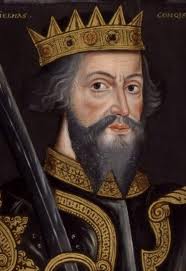
News of William's invasion reached Harold probably on 1 October - at roughly the same time that William received word of Harold's victory - while Harold was resting his army at York. He therefore had to return to the south coast, via London probably to arrange new levies to fill his army, arriving on 13 October. In the meantime the two sides communicated through messages. William offered Harold the earldom of WessexAn Anglo-Saxon kingdom in the south of England, and a noble house. After Anglo-Saxon times, the term has been used to refer to the south west of England (excluding Cornwall).An Anglo-Saxon kingdom in the south of England, and a noble house. After Anglo-Saxon times, the term has been used to refer to the south west of England (excluding Cornwall).An Anglo-Saxon kingdom in the south of England, and a noble house. After Anglo-Saxon times, the term has been used to refer to the south west of England (excluding Cornwall). if he were to step down as king; 'Harold, rather less generously, promised to let William return to Normandy unmolested if he made reparations for the damage he caused.' Morris, The Norman Conquest, p. 174.
Morris, The Norman Conquest, p. 174.
Unsurprisingly, neither side backed down and the stage was set for a second battle, at least for Harold. Having travelled the length of the country twice in a month (and fought a battle in between), Harold was forced to meet William, and with an ill-prepared army. Perhaps Harold should have waited longer in London for reinforcements: his family and the medieval chroniclers, as well as most historians, all thought so. But every day he delayed gave the Normans more time to pillage the countryside around Hastings, and to kill and maim the local peasantry. It is also possible that Harold attempted to take the enemy by surprise by attacking sooner than expected, rather like he did at Stamford Bridge.
The Battle of Hastings
Whether Harold intended to surprise William or not, on 14 October 1066 it was Harold who was surprised and taken unprepared by the approach of the Norman army. The army was actually made up of more than Normans, for Duke William had undertaken a recruitment drive across the whole of northern France. Many Frenchmen swelled the ranks of his army, probably thanks to the promises of bootyValuable stolen goods, especially those seized in war.Valuable stolen goods, especially those seized in war.Valuable stolen goods, especially those seized in war. and inspired by the Pope's endorsement of the venture. William, forewarned of Harold's approach from London, had kept his army up all of the preceding night in readiness, and set out at sunrise to find him. The two forces met at Senlac, about six miles inland from Hastings,
The army was actually made up of more than Normans, for Duke William had undertaken a recruitment drive across the whole of northern France. Many Frenchmen swelled the ranks of his army, probably thanks to the promises of bootyValuable stolen goods, especially those seized in war.Valuable stolen goods, especially those seized in war.Valuable stolen goods, especially those seized in war. and inspired by the Pope's endorsement of the venture. William, forewarned of Harold's approach from London, had kept his army up all of the preceding night in readiness, and set out at sunrise to find him. The two forces met at Senlac, about six miles inland from Hastings, Orderic Vitalis, who wrote fifty years after the battle, provided us with the name 'Senlac', but the D version of the Anglo-Saxon Chronicle described it as the place of the 'grey apple tree'. After the battle, the place simply became known as Battle. at roughly nine o-clock in the morning. A sudden rush to arms followed, with William reportedly in such a hurry that he put his mail shirt on back-to-front.
Orderic Vitalis, who wrote fifty years after the battle, provided us with the name 'Senlac', but the D version of the Anglo-Saxon Chronicle described it as the place of the 'grey apple tree'. After the battle, the place simply became known as Battle. at roughly nine o-clock in the morning. A sudden rush to arms followed, with William reportedly in such a hurry that he put his mail shirt on back-to-front. Not a good omen.
Not a good omen.
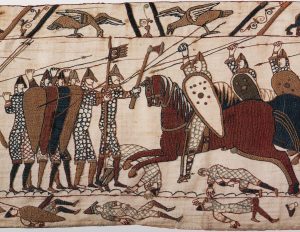
We don't know who had the larger army, as both sides insisted theirs was the smallest. The English used it as an excuse, the Normans to show their better skills and valourShowing great courage in the face of danger.Showing great courage in the face of danger.Showing great courage in the face of danger.. Harold had the better ground (he was uphill), but William the better tactics, considerably more archers, and cavalry.
The English used it as an excuse, the Normans to show their better skills and valourShowing great courage in the face of danger.Showing great courage in the face of danger.Showing great courage in the face of danger.. Harold had the better ground (he was uphill), but William the better tactics, considerably more archers, and cavalry. The English tended to use horses only for travelling and not for fighting, relying instead upon the shield wall. It would seem that Harold, in his haste to reach the invading army, hadn't recruited enough men: the Bayeux Tapestry, for example, shows just one English archer, compared with dozens on the Norman side.
The English tended to use horses only for travelling and not for fighting, relying instead upon the shield wall. It would seem that Harold, in his haste to reach the invading army, hadn't recruited enough men: the Bayeux Tapestry, for example, shows just one English archer, compared with dozens on the Norman side. The Tapestry is, in fact, an embroidery, and was made in Canterbury.
The Tapestry is, in fact, an embroidery, and was made in Canterbury.
Despite these discrepancies, the battle was hard-fought and lasted all day. While the English held the higher ground and didn't break rank they stood a chance of winning, even against cavalry, who couldn't charge up such difficult ground. The shield wall served them well, as contemporarySomeone or something living or occurring at the same time.Someone or something living or occurring at the same time.Someone or something living or occurring at the same time. chronicler and chaplain to William, William of Poitiers, wrote: 'It was an unheard-of kind of combat, with one side launching ceaseless attacks and manoeuvres, the other standing firmly as though rooted to the ground.' William of Poitiers, Gesta Guillelmi II ducis Normannorum, 2.21. Historians have questioned some of William of Poitiers' writing for accuracy. There was one Norman though, who according to the Carmen de Hastingae Proelio ('Song of the Battle of Hastings') eventually convinced an English warrior to leave the shield wall. The Norman, Taillefer, rode between the armies jeering at the English and juggling his sword, encouraging any man who dared to try his luck in single combat. Eventually, one Englishman became so irritated that he went forward to cut the Norman down, but failed. Instead, it was the Anglo-Saxon who was run through with the knight's lance, before being decapitated and having his head displayed as a trophy.
William of Poitiers, Gesta Guillelmi II ducis Normannorum, 2.21. Historians have questioned some of William of Poitiers' writing for accuracy. There was one Norman though, who according to the Carmen de Hastingae Proelio ('Song of the Battle of Hastings') eventually convinced an English warrior to leave the shield wall. The Norman, Taillefer, rode between the armies jeering at the English and juggling his sword, encouraging any man who dared to try his luck in single combat. Eventually, one Englishman became so irritated that he went forward to cut the Norman down, but failed. Instead, it was the Anglo-Saxon who was run through with the knight's lance, before being decapitated and having his head displayed as a trophy.
After a hard morning and afternoon of fighting, the Normans turned tail and seemed to flee the battlefield. There are differing accounts of why this happened: maybe a rumour spread that William of Normandy had been killed, or perhaps it was a ruse that turned into a real panic. Whatever the cause, all sources state that William had to take off his helmet and assure his troops that he was alive before they calmed. But importantly, it encouraged the English to break rank, leaving the safety of their shield wall and hilltop position to pursue the Normans down the hill. With the Anglo-Saxons now on equal ground, Norman superiority became clear. By the time the Normans were finished with them, there weren't enough English left to form an effective shield wall. Still they might have fought on, but for the news that Harold had fallen.
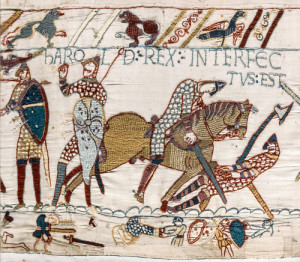
Popular myth says that Harold was shot in the eye with an arrow, but this is based on a misreading of the Bayeux Tapestry and the reports of later writers. ContemporarySomeone or something living or occurring at the same time.Someone or something living or occurring at the same time. chroniclers tend not to mention an arrow, but the Carmen states he was hacked to death by William and his knights. There could also be a pleasanter - although much less likely - end to Harold's tale: the rumour goes that he was rescued after the battle and somehow survived his wounds to live out his days as a monk, either in Essex or at a local abbey. Some reports state that William refused to allow Harold a proper burial, or that the body, which was too broken to be identifiable, was not returned to the family. This, of course, gives a bit more credence to the story.
Some reports state that William refused to allow Harold a proper burial, or that the body, which was too broken to be identifiable, was not returned to the family. This, of course, gives a bit more credence to the story.
Once the English king was killed, there seemed little point for the remains of the exhausted and defeated army to continue the fight. Instead, those who could turned and fled. Most did not get very far: they were chased by the victors on horseback and were cut down. According to William of Poitiers, 'Far and wide the earth was covered with the flower of the English nobilityThe highest hereditary stratum of the aristocracyA generic term for the highest social class. , sitting immediately below the monarch in terms of blood and title; or the quality of being noble (virtuous, honourable, etc.) in character. and youth, drenched in gore.' William of Poitiers, Gesta Guillelmi, 2.25. In 1070, the Pope Alexander II ordered William to do penance for the bloodshed caused during the invasion, who built Battle Abbey on the exact place Harold fell. However, as they were participating in a holy war, the penances were not as hard as they could have been and tended to be framed in loose terms. But not only the English suffered: as the Normans pursued the English into the night, many were killed when they rushed unawares into an old rampart.
William of Poitiers, Gesta Guillelmi, 2.25. In 1070, the Pope Alexander II ordered William to do penance for the bloodshed caused during the invasion, who built Battle Abbey on the exact place Harold fell. However, as they were participating in a holy war, the penances were not as hard as they could have been and tended to be framed in loose terms. But not only the English suffered: as the Normans pursued the English into the night, many were killed when they rushed unawares into an old rampart.
Aftermath
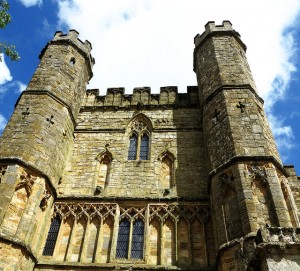
After the battle, William waited in Hastings for the Saxon nobles to pay him homage. Although William of Poitiers reported that 'the forces of Normandy had subjugated all the cities of the English in a single day', Quoted in Morris, The Norman Conquest, p.191 the Normans had in fact just taken a tiny part of Sussex. It was therefore a far safer strategy to wait in Norman-controlled territory for the Anglo-Saxons to come to him than it was to march on London.
Quoted in Morris, The Norman Conquest, p.191 the Normans had in fact just taken a tiny part of Sussex. It was therefore a far safer strategy to wait in Norman-controlled territory for the Anglo-Saxons to come to him than it was to march on London.
Many of the English, however, had other ideas. No-one came to Hastings to surrender and instead the 13-year-old great-nephew of Edward the Confessor, Edgar Ætheling, was declared king. Edgar Ætheling actually had a better claim to the throne than Harold. After two weeks of waiting, William left Hastings and went further along the coast, first to Romney,
Edgar Ætheling actually had a better claim to the throne than Harold. After two weeks of waiting, William left Hastings and went further along the coast, first to Romney, Which was burnt in response to its inhabitants attacking some of the Norman invading force which went off course. and then on to Dover. Here they burnt the town, although perhaps accidentally, and, due to drinking water and eating freshly-killed meat, came down with dysentery. Those well enough continued with William to London, with many towns along the way (including Winchester, the home of the Treasury) surrendering to them. London was less easy to subdue. After a skirmishSmall and unplanned bouts of fighting.Small and unplanned bouts of fighting.Small and unplanned bouts of fighting. perhaps on the bridge between the Londoners and the Normans, they both retreated and William set about harrying the surrounding countryside, a standard technique used to bully the enemy into surrender. William's persistence, and his crossing of the Thames at Wallingford to harry the land around London, gradually wore down Edgar's supporters. By December, London's resistance had collapsed and Edgar, with his remaining nobles, went to Berkhamstead to pay homage to William.
Which was burnt in response to its inhabitants attacking some of the Norman invading force which went off course. and then on to Dover. Here they burnt the town, although perhaps accidentally, and, due to drinking water and eating freshly-killed meat, came down with dysentery. Those well enough continued with William to London, with many towns along the way (including Winchester, the home of the Treasury) surrendering to them. London was less easy to subdue. After a skirmishSmall and unplanned bouts of fighting.Small and unplanned bouts of fighting.Small and unplanned bouts of fighting. perhaps on the bridge between the Londoners and the Normans, they both retreated and William set about harrying the surrounding countryside, a standard technique used to bully the enemy into surrender. William's persistence, and his crossing of the Thames at Wallingford to harry the land around London, gradually wore down Edgar's supporters. By December, London's resistance had collapsed and Edgar, with his remaining nobles, went to Berkhamstead to pay homage to William.
William was crowned in Westminster Abbey on Christmas Day 1066, When confusion arose over the speaking of oaths in different languages, Norman soldiers stationed outside the abbey turned on the bystanders, killing them and burning the surrounding buildings, thinking rebellion had started. At least this is the excuse given by William of Poitiers for the destruction that day. Others think they were just 'over-exuberant'. Whatever the cause, it wasn't a particularly auspicious beginning to the reign. but the Conquest had only just begun. It would be another five years before William could say he was master of all England. Pockets of resistance continued across the country: Chester didn’t fall to the Normans until 1070 and Hereward the Wake resisted from the Isle of Ely, in the middle of the Lincolnshire Fens, until 1071.
When confusion arose over the speaking of oaths in different languages, Norman soldiers stationed outside the abbey turned on the bystanders, killing them and burning the surrounding buildings, thinking rebellion had started. At least this is the excuse given by William of Poitiers for the destruction that day. Others think they were just 'over-exuberant'. Whatever the cause, it wasn't a particularly auspicious beginning to the reign. but the Conquest had only just begun. It would be another five years before William could say he was master of all England. Pockets of resistance continued across the country: Chester didn’t fall to the Normans until 1070 and Hereward the Wake resisted from the Isle of Ely, in the middle of the Lincolnshire Fens, until 1071. The Isle fell when local monks were bribed into revealing the secret route to the island through the bogs. It is said that Hereward escaped and, according to the account, was either pardoned by William or lived as an outlaw in the Fens.
The Isle fell when local monks were bribed into revealing the secret route to the island through the bogs. It is said that Hereward escaped and, according to the account, was either pardoned by William or lived as an outlaw in the Fens.
Things to think about
- Did William of Normandy have a legitimate claim to the English throne?
- What had Harold Godwinsson been doing to get shipwrecked in Normandy in the first place?
- How did Harold Godwinsson die?
- Could the Anglo-Saxons under Harold Godwinsson have won the Battle of Hastings?
- How easy was it for William to subdue the Anglo-Saxons after the Battle of Hastings?
Things to do
- Visit Battle Abbey, the battlefield and visitor centre, owned by English Heritage. If possible, time it right and see one of their living history or re-enactment events. You can find out more information about visiting here.
- What would be a more accurate version of the Bayeux Tapestry? Draw your own version of it!
Further reading
There tends to be a split in the thinking of historians, between pro-Normans and pro-Anglo-Saxons. Although Marc Morris would object to this label. Two books that reflect this split are Marc Morris's The Norman Conquest - The Battle of Hastings and the Fall of Anglo-Saxon England and Ian Walker's Harold: The Last Anglo-Saxon King.
Although Marc Morris would object to this label. Two books that reflect this split are Marc Morris's The Norman Conquest - The Battle of Hastings and the Fall of Anglo-Saxon England and Ian Walker's Harold: The Last Anglo-Saxon King.
- Log in to post comments


